Today, I am bringing you an article published by Jiangnan University Chen Long 2017 Food Chemistry, the application of nuclear magnetic resonance technology in the rapid determination of oil and water content in simulated fried food systems.
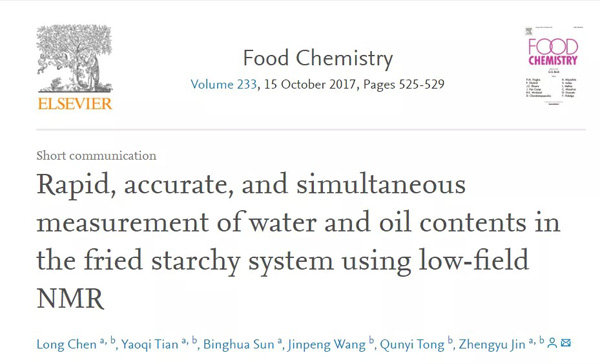
1.Conclusion: LF-NMR can be used for simultaneous analysis of oil and water content in fried food systems
2.Methodological basis: Combined with the drying experiment of oven, the attribution of oil-water signal in the low-field nuclear magnetic transverse relaxation spectrum of fried food system was determined. It was found that the oil-water signal did not overlap and had a clear independent boundary. This is a method for simultaneous determination of water-oil content by LF-NMR. The establishment of the foundation laid the foundation.
3.Advantage: First of all, LF-NMR technology is non-destructive, fast and green. Compared with the traditional Soxhlet extraction and drying methods, it has great method advantages, no chemical reagents, and is harmless to the human body and green. Compared to the near infrared method, Low-field nuclear magnetic is a direct test, and does not require a large number of models. For the phenomenon that the color of the oil frying process is gradually deepened, the low-field nuclear magnetic method is completely unrestricted, and it belongs to a method of integrating fast, accurate, rigorous, environmentally friendly and innovative.
Background
The oil and water content index in food is very important, but the current testing method is slightly behind.
There are many complex systems in which there are many oils and waters in the food. The content and distribution of the oil and water components determine the food quality and storage stability of the final food. The rapid increase in the incidence of obesity, cardiovascular and cerebrovascular diseases in the population in recent years has also prompted people to pay more and more attention to research on reducing oil content, controlling and reducing oil intake.
Conventional methods for determining oil water content – Soxhlet extraction, oven method, long time, poor stability, and vulnerability to interference
Exploring a fast, non-destructive, green approach is imperative
1.Principle & Results
1.1 Distinction of oil-water signal in starch-based frying simulation system
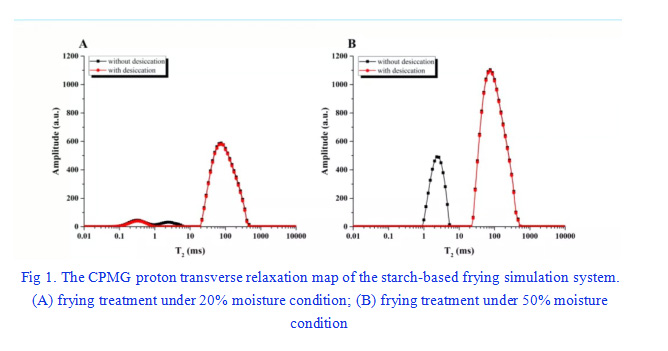
The transverse relaxation spectra of the fried samples were tested by LF-NMR, the fried samples were dried in an oven, and the transverse relaxation spectra of the samples were determined by LF-NMR. The differences in transverse relaxation spectra before and after drying were compared to determine the water and oil in the fried samples. signal. The frying process is selected after the soybean oil is fried at 180 ° C for 20 minutes.
LF-NMR detected that there were mainly oil and fat signal peaks and combined water signal peaks in the simulated starch-based frying system. The combined water signal peaks were divided into weakly bound water and strong bound water. The weakly bound water could be dried and removed at 105 °C. Strongly bound water is always retained in the sample (Figure 2). According to the characteristics of the water signal in the sample, the manganese ion is used in the experiment to reduce the relaxation behavior of the free water, so that the peak position of the water signal peak matches the peak position of the combined water signal in the sample.
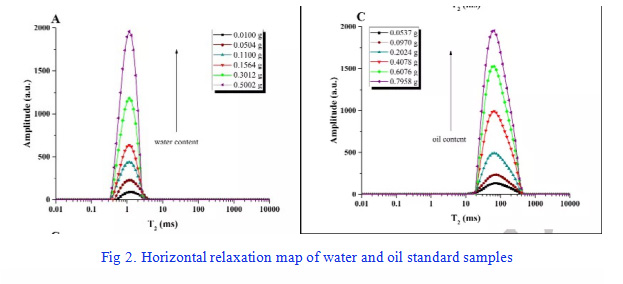
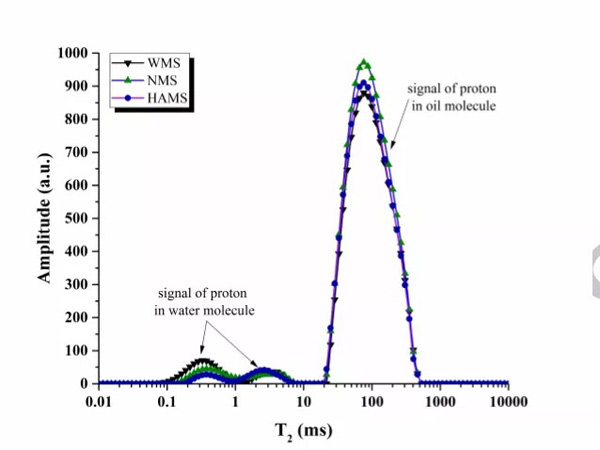
1.2 Water and oil standard curve production
The appropriate concentration of aqueous solution of manganese chloride is arranged so that the transverse relaxation peak position is consistent with the peak position of the moisture in the fried sample; a series of low-to-high manganese chloride aqueous solution and deep-frying oil are weighed, respectively The CPMG sequence was used to measure the water and oil quantitative standard curve with the respective mass as the abscissa and the peak integral area of the low field nuclear magnetic signal as the ordinate.
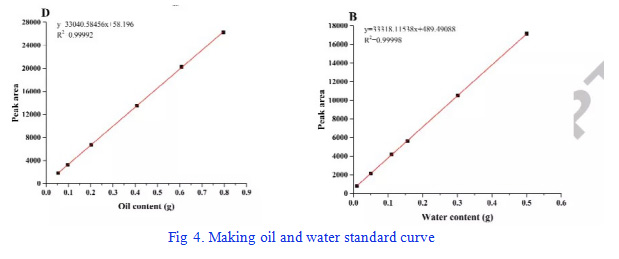
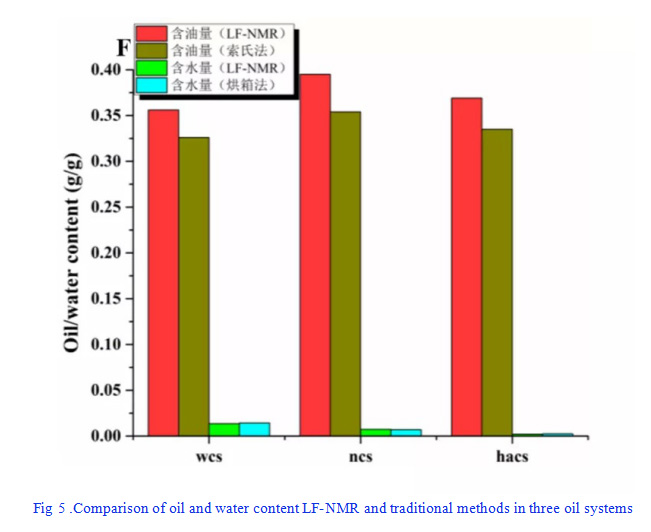
The relaxation signal of a series of oil and water standard samples was determined by LF-NMR technique. The standard working curve of water and oil was prepared by using the signal peak area of the standard as the ordinate and the mass of the standard as the abscissa (Fig. 4). The R2 is greater than 0.99, indicating that the low field nuclear magnetic technology can be well applied to the analysis and determination of water and oil content in fried foods.
Due to the variety of starch systems, three representative starches were selected: waxy corn starch (wcs), standard starch (ncs), and high amylose corn starch (hacs). The frying experiment was carried out under the experimental conditions, and the oil and water were calculated according to the marking. The content, and compared with the traditional method, found that the current LF-NMR method can well determine the water and oil content in the fried sample.
1.3 In-depth exploration
I believe that you see this, I feel that this paper should be over, but the author has done some very interesting experiments in exploring the scope of application of this method. After all, the moisture content of food objects is different, the frying temperature is different, so the author Further, the LF-NMR method was applied to the analysis of the influence of the frying parameters (moisture, grease temperature, frying time) on the water and oil content in the fried sample.
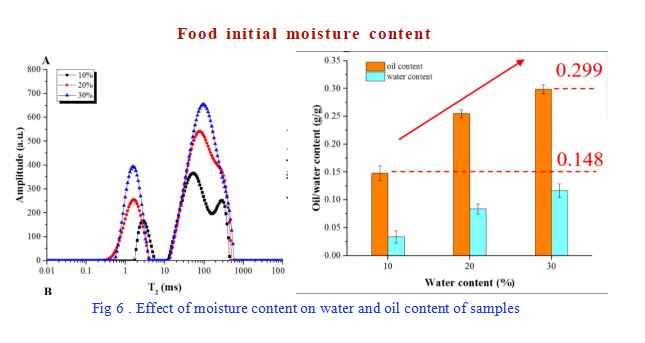
The frying temperature also affects the oil absorption characteristics of starch, but the impact is more complicated. Interested parties can download related articles. For ordinary corn starch, the lowest oil absorption at 180 °C.
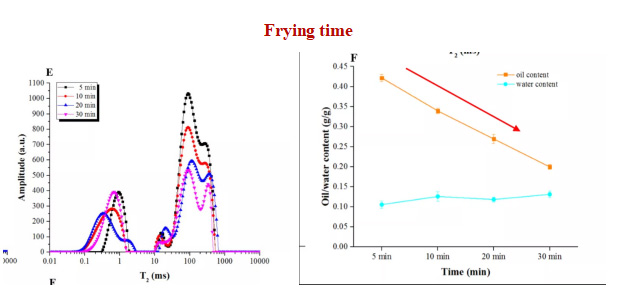
Interestingly, the absorption of oil by three kinds of starch decreased significantly with the prolonged frying time. This may be due to the expansion and breakage of some adsorbed starch granules due to the prolonged frying time, so that the adsorbed oil was released again.
Conclusion
1 This method is expected to be a rapid method for detecting oil and moisture content in foods in industrial frying.
2 Study on the oil adsorption and internal action mechanism of starch during frying
Reference:
Long Chen, Yaoqi Tian, Binghua Sun, Jinpeng Wang, Qunyi Tong, Zhengyu Jin*. Rapid, accurate, and simultaneous measurement of water and oil contents in the fried starchy system using low-field NMR, 2017, 233: 525-529 (Food Chemistry, SCI, IF=4.529, 食品科技一区,TOP期刊)
 NIUMAG
NIUMAG